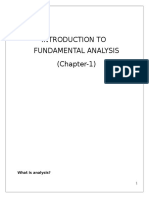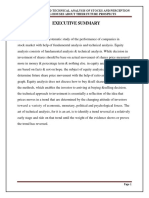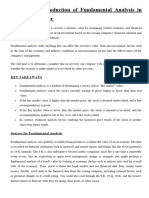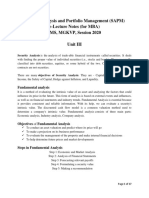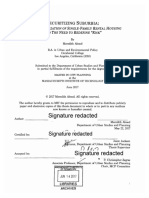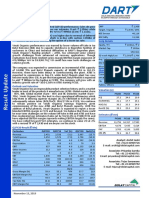Important Equity Research Terms With Examples
Important Equity Research Terms With Examples
Uploaded by
Aryan Hate0 ratings0% found this document useful (0 votes)
6 views13 pagesOriginal Title
Important Equity Research Terms with Examples
Copyright
© © All Rights Reserved
Available Formats
PDF, TXT or read online from Scribd
Share this document
Did you find this document useful?
Is this content inappropriate?
Report this DocumentCopyright:
© All Rights Reserved
Available Formats
Download as PDF, TXT or read online from Scribd
Download as pdf or txt
0 ratings0% found this document useful (0 votes)
6 views13 pagesImportant Equity Research Terms With Examples
Important Equity Research Terms With Examples
Uploaded by
Aryan HateCopyright:
© All Rights Reserved
Available Formats
Download as PDF, TXT or read online from Scribd
Download as pdf or txt
You are on page 1of 13
Het Parekh
Important Equity Research
Terms with Examples
Het Parekh
For aspiring analysts and
seasoned professionals alike, a
thorough understanding of equity
research terminology is crucial for
navigating this complex domain.
This post delves into essential
equity research terms, providing
examples to enhance
comprehension.
Het Parekh
1. Coverage Universe:
The coverage universe
encompasses the specific group of
companies or industries that an
analyst or research team focuses
on. Analysts typically specialize in a
particular sector, such as
technology or healthcare, gaining
in-depth knowledge of the
companies and trends within that
domain.
Example: An analyst covering the
technology sector may focus on
companies like Apple, Microsoft,
and Amazon.
Het Parekh
2. Due Diligence:
Due diligence refers to the rigorous
process of investigating and
evaluating a company's financial
health, management capabilities,
and competitive landscape.
Analysts conduct due diligence to
assess a company's investment
potential and identify potential
risks.
Example: An analyst evaluating a
potential investment in Tesla would
conduct due diligence on its electric
vehicle production, battery
technology, and regulatory
environment.
Het Parekh
3. Discounted Cash Flow (DCF) Analysis:
DCF analysis is a valuation
methodology that estimates the
intrinsic value of a company by
projecting future cash flows to the
present. Analysts use DCF models to
assess a company's worth and
determine whether it is undervalued
or overvalued.
Example: An analyst valuing a retail
company would project its future
sales, expenses, and cash flows to
determine its intrinsic value and
compare it to its current market
price.
Het Parekh
4. Earnings Estimates:
Earnings estimates represent analysts'
predictions of a company's future
earnings per share (EPS). These
estimates are based on factors such as
historical performance, industry
trends, and management guidance.
Example: An analyst covering a
pharmaceutical company might
estimate its future earnings based on
the projected sales of its new drug
pipeline.
Het Parekh
5. Key Performance Indicators (KPIs):
KPIs are quantifiable metrics that
measure a company's
performance and health. Analysts
use KPIs to assess various aspects
of a company's operations, such
as profitability, efficiency, and
market share.
Example: A retail analyst might
track KPIs such as sales per square
foot, inventory turnover, and
customer satisfaction to evaluate
a company's performance.
Het Parekh
6. Peer Group Analysis:
Peer group analysis involves
comparing a company's financial
performance and valuation
metrics to those of its industry
peers. This analysis helps analysts
identify the company's relative
strengths and weaknesses.
Example: An analyst evaluating a
technology company would
compare its financial ratios, such
as P/E ratio and gross margin, to
those of its industry competitors.
Het Parekh
7. Price Targets:
Price targets represent analysts'
forecasts of a company's stock
price within a specified timeframe.
These targets are based on the
analyst's assessment of the
company's value and future
prospects
Example: An analyst covering a
biotechnology company might set
a price target of $150 per share,
reflecting its belief in the
company's potential for
breakthrough drug approvals.
Het Parekh
8. Sector Rotation:
Sector rotation refers to the
cyclical shift of investor
preference towards specific
industries or sectors. Analysts
monitor sector rotation trends to
identify potential investment
opportunities and risks.
Example: An analyst might observe
a sector rotation into technology
stocks as investors anticipate
increased demand for digital
products and services.
Het Parekh
9. Stock Ratings:
Stock ratings, such as "buy,"
"hold," or "sell," represent
analysts' recommendations on
whether investors should
purchase, maintain, or sell a
particular stock. These ratings are
based on the analyst's assessment
of the company's risk-adjusted
return potential.
Example: An analyst might
upgrade a stock from "hold" to
"buy" if they believe the
company's recent product launch
has significantly increased its
growth prospects.
Het Parekh
In conclusion, these essential
equity research terms provide a
foundation for understanding
the intricacies of this field. By
mastering these concepts,
analysts and investors can make
informed investment decisions
and navigate the complex world
of equity research.
Follow me on LinkedIn for
more such insightful content
on Finance
You might also like
- Fundamental AnalysisDocument8 pagesFundamental AnalysisNiño Rey LopezNo ratings yet
- Fundamental Analysis of ICICI BankDocument70 pagesFundamental Analysis of ICICI BankAnonymous TduRDX9JMh0% (1)
- Equity Research - A Complete Beginners GuideDocument19 pagesEquity Research - A Complete Beginners GuideOwen67% (3)
- Fundamental AnalysisDocument6 pagesFundamental Analysisumasahithi91No ratings yet
- Equity Research and AnalysisDocument60 pagesEquity Research and AnalysisSmit VyasNo ratings yet
- Executive SummaryDocument63 pagesExecutive SummarymaisamNo ratings yet
- Fundamental Analysis Principles, Types, and How To Use It $$$$$Document8 pagesFundamental Analysis Principles, Types, and How To Use It $$$$$ACC200 MNo ratings yet
- Fundamental Analysis of ICICI BankDocument79 pagesFundamental Analysis of ICICI BanksantumandalNo ratings yet
- Wealth Management ProjectDocument24 pagesWealth Management ProjectshrishtiNo ratings yet
- Valuation-Ch 01 Part OneDocument16 pagesValuation-Ch 01 Part OneMostafa HossamNo ratings yet
- Fundamental of ValuationDocument39 pagesFundamental of Valuationkristeen1211No ratings yet
- CH 1 P1 PDFDocument16 pagesCH 1 P1 PDFAhmed RedaNo ratings yet
- Valuation and TradingDocument22 pagesValuation and TradingKathryn FlemingNo ratings yet
- Fundamental AnalysisDocument6 pagesFundamental AnalysisMuhammad JunaidNo ratings yet
- Fundamental AnalysisDocument7 pagesFundamental AnalysisJyothi Kruthi PanduriNo ratings yet
- Q1 Explain What Is CAMELS Framework Used in Banking AnalysisDocument2 pagesQ1 Explain What Is CAMELS Framework Used in Banking Analysisshubham ghodkeNo ratings yet
- Kunal BLACK BOOK @Document71 pagesKunal BLACK BOOK @Rio duttNo ratings yet
- Fundamental Analysis Versus Technical AnalysisDocument12 pagesFundamental Analysis Versus Technical AnalysisShakti ShuklaNo ratings yet
- 404 Unit 1Document15 pages404 Unit 1505 Akanksha TiwariNo ratings yet
- Project Report ON Equity Analysis of A Firm Using Various Analysis and Valuation TechniquesDocument27 pagesProject Report ON Equity Analysis of A Firm Using Various Analysis and Valuation Techniquessanjana jainNo ratings yet
- What Is Equity ResearchDocument12 pagesWhat Is Equity ResearchAryan HateNo ratings yet
- Get To Know: Equity ResearchDocument7 pagesGet To Know: Equity ResearchtmendisNo ratings yet
- 404Document22 pages404505 Akanksha TiwariNo ratings yet
- Security Analysis Topic9Document16 pagesSecurity Analysis Topic9Kaushali WeerakkodyNo ratings yet
- Fundamental Analysis Black BookDocument46 pagesFundamental Analysis Black Bookwagha25% (4)
- Fundamental AnalysisDocument18 pagesFundamental AnalysisChandan KNNo ratings yet
- 0 - Project 1 FINAL PDFDocument53 pages0 - Project 1 FINAL PDFShree ShaNo ratings yet
- Investment-Approaches To Equity AnalysisDocument47 pagesInvestment-Approaches To Equity AnalysisAyushi ChoumalNo ratings yet
- Fundamentals of Valuation: Chapter One: IntroductionDocument16 pagesFundamentals of Valuation: Chapter One: IntroductionAhmed RedaNo ratings yet
- SAPM1Document5 pagesSAPM1Shaan MahendraNo ratings yet
- Comparative Analysis of Same Sized IT Companies Based On Their Business ValuationDocument5 pagesComparative Analysis of Same Sized IT Companies Based On Their Business ValuationVarsha BhatiaNo ratings yet
- The Power of Charts: Using Technical Analysis to Predict Stock Price MovementsFrom EverandThe Power of Charts: Using Technical Analysis to Predict Stock Price MovementsNo ratings yet
- Equity ResearchDocument16 pagesEquity ResearchbhaskkarNo ratings yet
- Activity On Stock Markets CAED102 Financial MarketsDocument4 pagesActivity On Stock Markets CAED102 Financial MarketsRico Jr. PeñaredondoNo ratings yet
- Fundamental Analyses Vs Technical AnalysesDocument91 pagesFundamental Analyses Vs Technical AnalysesNilesh PandeyNo ratings yet
- Guide DisplayDocument3 pagesGuide DisplayXerach GHNo ratings yet
- Fundamental AnalysisDocument22 pagesFundamental AnalysisDanilo FreitasNo ratings yet
- Intermediate Techniques For Any Stock MarketDocument2 pagesIntermediate Techniques For Any Stock MarketTerror WizardNo ratings yet
- Bond and Equity Trading Strategies UZ Assignment 2Document15 pagesBond and Equity Trading Strategies UZ Assignment 2Milton ChinhoroNo ratings yet
- We TubeDocument38 pagesWe TubeGaurav ChikhalikarNo ratings yet
- Day 1 MergedDocument3 pagesDay 1 MergedManishNo ratings yet
- FMTEXINDUNIT4Document29 pagesFMTEXINDUNIT4Gopika RaviNo ratings yet
- Ra 1Document7 pagesRa 1ranveer78krNo ratings yet
- What Is Fundamental AnalysisDocument13 pagesWhat Is Fundamental AnalysisvishnucnkNo ratings yet
- Financial AnalystDocument3 pagesFinancial AnalystRohit BhandariNo ratings yet
- FinanceDocument8 pagesFinancepiyush kumarNo ratings yet
- Fundamental Analysis DefinitionDocument14 pagesFundamental Analysis DefinitionGerald HandersonNo ratings yet
- Fundamental Analysis Covering EICDocument15 pagesFundamental Analysis Covering EICsatinderpalkaurNo ratings yet
- Technical Analysis: Learn To Analyse The Market Structure And Price Action And Use Them To Make Money With Tactical Trading StrategiesFrom EverandTechnical Analysis: Learn To Analyse The Market Structure And Price Action And Use Them To Make Money With Tactical Trading StrategiesRating: 4 out of 5 stars4/5 (40)
- Equity Shares 3Document4 pagesEquity Shares 3Sci UpscNo ratings yet
- Fundamental Analysis 12Document5 pagesFundamental Analysis 12Pranay KolarkarNo ratings yet
- A Study On Fundamental Analysis and Its Impact On Indian Stock MarketDocument111 pagesA Study On Fundamental Analysis and Its Impact On Indian Stock MarketKarthik Kartu J100% (1)
- Security Analysis and Portfolio Management (SAPM) E-Lecture Notes (For MBA) IMS, MGKVP, Session 2020Document17 pagesSecurity Analysis and Portfolio Management (SAPM) E-Lecture Notes (For MBA) IMS, MGKVP, Session 2020Sukanya ShridharNo ratings yet
- Fundamental AnalysisDocument4 pagesFundamental Analysisgabby209No ratings yet
- Company AnalysisDocument84 pagesCompany AnalysisShantnu SoodNo ratings yet
- Fundamental & Technical Analysis of Portfolio ManagementDocument28 pagesFundamental & Technical Analysis of Portfolio ManagementSaili SarmalkarNo ratings yet
- Unit IIDocument9 pagesUnit IIRaj VermaNo ratings yet
- Fundamental Analysis: Stock Trading Analysis/IndicatorsDocument5 pagesFundamental Analysis: Stock Trading Analysis/IndicatorsAngie LeeNo ratings yet
- Investopedia Explains Cross-Sectional AnalysisDocument1 pageInvestopedia Explains Cross-Sectional AnalysisAli NdlovuNo ratings yet
- Equity Research GuideDocument60 pagesEquity Research GuideAnkit AryanNo ratings yet
- Guide To Capital Asset Pricing Model!Document11 pagesGuide To Capital Asset Pricing Model!Aryan HateNo ratings yet
- Mutual Fund FactsheetDocument8 pagesMutual Fund FactsheetAryan HateNo ratings yet
- Financial Modeling and ValuationDocument16 pagesFinancial Modeling and ValuationAryan HateNo ratings yet
- Finternet - The Financial System of The Future. (BIS Working Paper)Document44 pagesFinternet - The Financial System of The Future. (BIS Working Paper)Aryan HateNo ratings yet
- Financial Analyst Interview QuestionsDocument10 pagesFinancial Analyst Interview QuestionsAryan HateNo ratings yet
- Fuchs Model of Inter-Sectoral Shift in Employment (Document16 pagesFuchs Model of Inter-Sectoral Shift in Employment (Aryan HateNo ratings yet
- XLSTM: Extended Long Short-Term MemoryDocument55 pagesXLSTM: Extended Long Short-Term MemoryAryan HateNo ratings yet
- Effects of Barriers To Trade in ServicesDocument14 pagesEffects of Barriers To Trade in ServicesAryan HateNo ratings yet
- Clark - Fisher ModelDocument23 pagesClark - Fisher ModelAryan HateNo ratings yet
- Apollo - US Housing OutlookDocument115 pagesApollo - US Housing OutlookAryan HateNo ratings yet
- Private Markets Quarterly UpdateDocument37 pagesPrivate Markets Quarterly UpdateAryan HateNo ratings yet
- Varun Beverage Limited ModelDocument15 pagesVarun Beverage Limited ModelAryan HateNo ratings yet
- UntitledDocument7 pagesUntitledAryan HateNo ratings yet
- Harmonisation of ISO 20022: Partnering With Industry For Faster, Cheaper, and More Transparent Cross-Border PaymentsDocument13 pagesHarmonisation of ISO 20022: Partnering With Industry For Faster, Cheaper, and More Transparent Cross-Border PaymentsAryan HateNo ratings yet
- International Financial Messaging Systems: July 19, 2021Document20 pagesInternational Financial Messaging Systems: July 19, 2021Aryan HateNo ratings yet
- Applied Econometrics: Two-Day Workshop OnDocument6 pagesApplied Econometrics: Two-Day Workshop OnAryan HateNo ratings yet
- Resume For Finance StudentDocument4 pagesResume For Finance Studentafllxjwyf100% (1)
- Greenlam Industries LTD: Treading A Five-Year Growth PathDocument6 pagesGreenlam Industries LTD: Treading A Five-Year Growth Pathagrawal.minNo ratings yet
- GHGL and GVGL: Steadily Expanding Portfolios: GHGL - Further Diversifying Its Product PortfolioDocument3 pagesGHGL and GVGL: Steadily Expanding Portfolios: GHGL - Further Diversifying Its Product PortfolioHussain AliNo ratings yet
- Thiran Kavinda Ranasinghe: Career ObjectiveDocument2 pagesThiran Kavinda Ranasinghe: Career ObjectiveHjnzerNo ratings yet
- Da TypesDocument21 pagesDa TypeskolleruNo ratings yet
- Task #1: James Is A Systems Analyst On A New Account Management System For Hometown NationalDocument1 pageTask #1: James Is A Systems Analyst On A New Account Management System For Hometown NationalAlyssa Rae FedericoNo ratings yet
- Barclays Capital Tuesday Credit Call 20 September 2011Document22 pagesBarclays Capital Tuesday Credit Call 20 September 2011poitrenacNo ratings yet
- Valuation of Companies'Document48 pagesValuation of Companies'Ali SaifyNo ratings yet
- BFN1014 Assignment (T2, 201516) VDocument4 pagesBFN1014 Assignment (T2, 201516) VAlya IbrahimNo ratings yet
- Cover Letter - ING BankDocument1 pageCover Letter - ING BankAnas HadiNo ratings yet
- Bank of America Capital Market OutlookDocument8 pagesBank of America Capital Market OutlookAceNo ratings yet
- Pricol - CU-IDirect-Mar 3, 2022Document6 pagesPricol - CU-IDirect-Mar 3, 2022rajesh katareNo ratings yet
- Credit Risk Analyst Resume Samples - Velvet JobsDocument160 pagesCredit Risk Analyst Resume Samples - Velvet Jobsposei100% (1)
- Britannia: Performance HighlightsDocument11 pagesBritannia: Performance HighlightsAngel BrokingNo ratings yet
- Vanita Black Book FINALDocument78 pagesVanita Black Book FINALVikas SinghNo ratings yet
- 2019ProspectusUNZA UndergradDocument20 pages2019ProspectusUNZA UndergradSimwene LunguNo ratings yet
- CFA Level II Mock Exam 6 - Questions (PM)Document32 pagesCFA Level II Mock Exam 6 - Questions (PM)Sardonna FongNo ratings yet
- Pharma Will It Be A Dark Horse SOICDocument50 pagesPharma Will It Be A Dark Horse SOICrayijo4527No ratings yet
- Handbook of English 1 (STIER) - 1Document7 pagesHandbook of English 1 (STIER) - 1Sarah AnggrainiNo ratings yet
- Amegy Presentation 11 7 13Document13 pagesAmegy Presentation 11 7 13api-236601493No ratings yet
- Bii Global Outlook 2024Document16 pagesBii Global Outlook 2024harikevadiya4No ratings yet
- A Financial and Strategic Analysis of AmDocument130 pagesA Financial and Strategic Analysis of AmRa JaNo ratings yet
- Gratitude in ActionDocument19 pagesGratitude in Actionrg DelacernaNo ratings yet
- National Public Hearing Consultation On The Proposed Policies Standards and Guidelines For Bachelor of Science in Legal Management Program 2Document33 pagesNational Public Hearing Consultation On The Proposed Policies Standards and Guidelines For Bachelor of Science in Legal Management Program 2Ferrer, John Robert L.No ratings yet
- Securitizing SuburbiaDocument105 pagesSecuritizing SuburbiaForeclosure FraudNo ratings yet
- Asahi Songwon Colors (NSE - ASAHISONG) - Jul'18 Alpha - Alpha Plus Stock - Katalyst WealthDocument9 pagesAsahi Songwon Colors (NSE - ASAHISONG) - Jul'18 Alpha - Alpha Plus Stock - Katalyst WealthjesprileNo ratings yet
- Dolat Capital Market - Vinati Organics - Q2FY20 Result Update - 1Document6 pagesDolat Capital Market - Vinati Organics - Q2FY20 Result Update - 1Bhaveek OstwalNo ratings yet
- Must ReadDocument18 pagesMust ReadWency CompraNo ratings yet
- Esma50-165-1524 TRV 1 2021Document119 pagesEsma50-165-1524 TRV 1 2021ForkLogNo ratings yet
- Ambit - Highest Conviction Buys & Sells From AmbitDocument11 pagesAmbit - Highest Conviction Buys & Sells From Ambitmaamir2000No ratings yet

